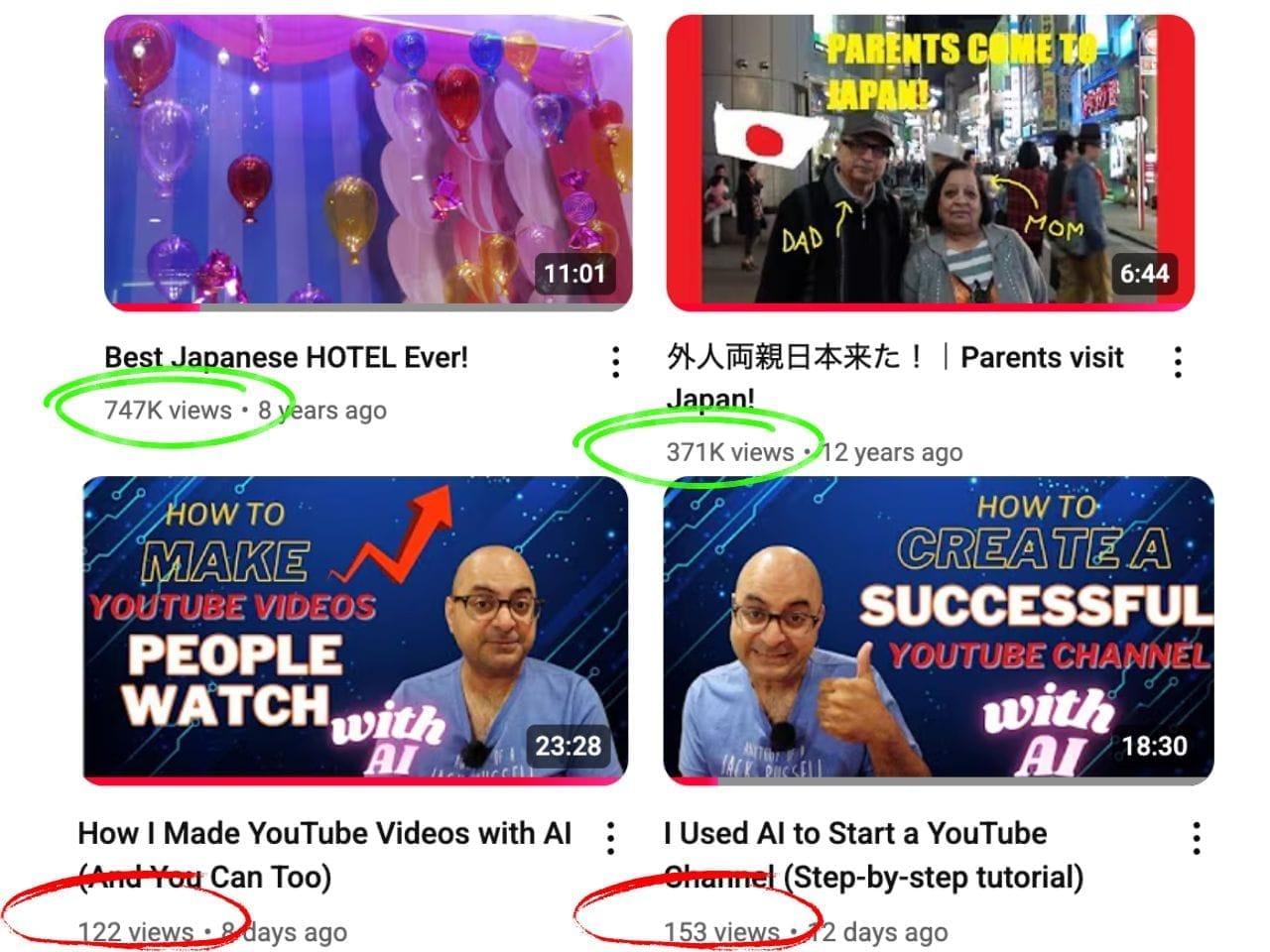How to Bring a Dead YouTube Channel Back to Life
I had the excitement of starting a channel in 2009.
I uploaded videos.
I hit “publish” and waited for the views to roll in. But then… nothing.
A handful of clicks, maybe a few likes, and then silence.
But over time, my channel grew and I ended up with millions of views and over 20,000 subscribers!
But then, each year, my views dropped, my subscribers slowly faded away, and despite continuously posting videos, my channel...died. (See images below to see my high views and then my current views)
If this sounds familiar, you’re not alone. But here’s the good news: a dead YouTube channel isn’t the end. It can be revived.
With the right strategy, you can breathe life back into your channel, grow an audience, and finally start seeing views again.
Let’s explore how to bring your YouTube channel back to life in 2025.

Why YouTube Channels Die in the First Place
Before we talk about revival, let’s face the truth about why so many channels stop growing:
Inconsistent uploads – YouTube rewards consistency. Long breaks often kill momentum.
Lack of focus – Random topics confuse the algorithm and the audience.
Weak hooks – If people click away in the first 10 seconds, YouTube stops promoting the video.
No SEO strategy – Without keywords in titles, descriptions, and tags, your videos never get discovered.
No promotion – Relying on YouTube alone to push your videos isn’t enough.
Sound familiar? Don’t worry. Recognizing the problems is the first step to fixing them.
In my situation, despite consistently uploading videos, my channel was doomed. I was living in Japan and uploading anything Japan-focused: life vlogs, restaurants, tourist videos, language lessons, crime, etc.
I had no clear niche.
I also moved back to Canada, and the following I had, only wanted Japan-focused videos. So my views and subscribers dropped.
How To Rise Up From The Dead
Step 1: Refresh Your Niche and Audience
One of the biggest reasons channels feel “dead” is a lack of clarity. Who are you creating for? What problem are you solving?
If your channel is all over the place, now’s the time to refocus your YouTube channel.
Ask yourself:
What topics do I enjoy enough to stick with for the long term?
Who do I want watching my content (in terms of age, interests, and struggles)?
Which topics have search demand on YouTube right now?
👉 Pro tip: Use tools like TubeBuddy, vidIQ, or even YouTube’s search bar to discover what people are actively searching for. Build your new comeback strategy around those keywords.
Step 2: Audit and Update Old Videos
Just because a channel feels dead doesn’t mean your old videos are useless. Reviving old content is one of the fastest ways to get views on YouTube again.
Update titles, descriptions, and tags with SEO-friendly keywords
Create new, eye-catching thumbnails (bright colors, big text, human faces).
Add cards and end screens that direct viewers to newer videos.
Re-share those videos on social media with fresh captions.
Sometimes, one small update can signal the YouTube algorithm to start promoting your videos again.
Step 3: Create a Comeback Series
Don’t just randomly post new content. Build anticipation with a YouTube comeback series.
Example: “Reviving My Dead Channel – Episode 1: Starting Fresh.” This is the method I went with.
This not only hooks your existing subscribers (they’ll want to see what happens) but also creates a story arc that keeps new viewers engaged.
Being transparent works wonders. Share your struggles, your mistakes, and what you’re doing differently now. People love following authentic journeys.
Step 4: Double Down on Shorts
In 2025, YouTube Shorts will be the fastest way to grow a channel again.
They work like TikToks or Reels, short, snappy, and highly shareable.
If your channel feels dead, Shorts can inject new life quickly:
Turn old videos into 30–60 second clips.
Add captions and bold text to grab attention.
Post consistently (1–2 Shorts per day if possible).
Once new viewers discover you through Shorts, they’ll trickle into your long-form videos and help restart your channel’s growth.
Step 5: Master the First 20 Seconds
YouTube cares about one thing: watch time. If people leave in the first 30 seconds, your video dies.
Here’s how to fix it:
Start with a hook – a bold statement, shocking fact, or big promise.
Show, don’t tell – dive straight into the value.
Keep the energy high – pacing matters more than ever.
👉 Example: Instead of starting with, “Hi guys, welcome back to my channel,” try: “Most YouTube channels die within a year — here’s how to make sure yours isn’t one of them.”
That simple shift can bring your YouTube channel back to life by holding audience attention.
Step 6: Engage With Your Audience
If your channel feels dead, start building a community instead of just chasing numbers.
Reply to every comment.
Ask questions in your videos and encourage feedback.
Create polls in your Community Tab.
Collaborate with small creators in your niche.
When viewers feel like they matter, they’ll keep coming back, which signals to YouTube that your channel deserves promotion.
Step 7: Stay Consistent (Even When It’s Slow)
The hardest part of YouTube is patience. Most “overnight success” channels were uploading for months (sometimes years) before their big break.
Commit to a schedule you can stick to, whether that’s 1 video per week or 2 videos per month. Consistency beats burnout every time.
Remember: reviving a dead YouTube channel is a marathon, not a sprint.
Here is my dead channel that I am trying to revive. I started by making a series of how to start YouTube to pivot from my Japan audience to a Ghost Your Job audience.
Bringing a YouTube channel back to life isn’t about luck.
It’s about strategy, focus, and persistence. To recap:
Refresh your niche.
Revive old videos.
Create a comeback series.
Leverage Shorts.
Hook viewers fast.
Build community.
Stay consistent.
Your channel isn’t gone forever. It’s waiting for you to breathe life back into it.
👉 If you’re serious about building an online presence (whether through YouTube, Instagram, or digital marketing), check out my digital store, which has free and paid resources to help you grow!
© 2025 S.A. Ozbourne ©
